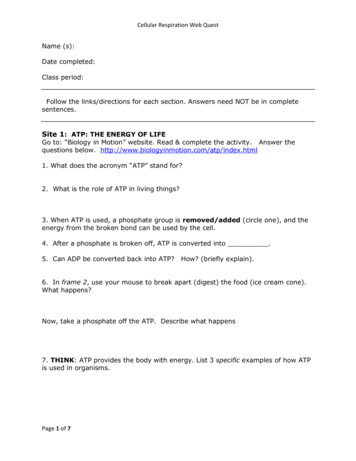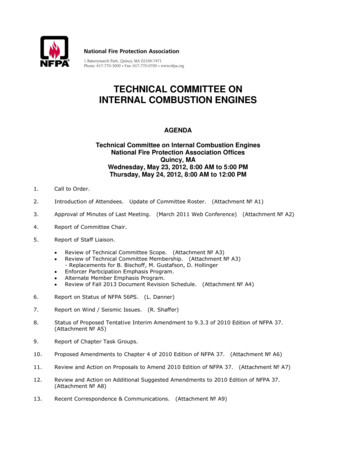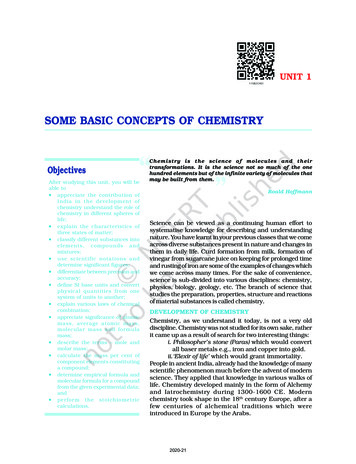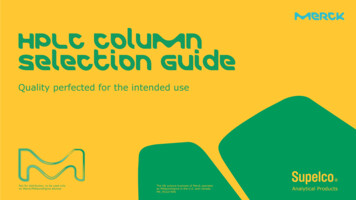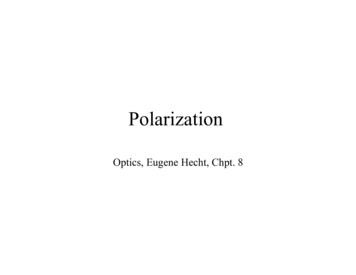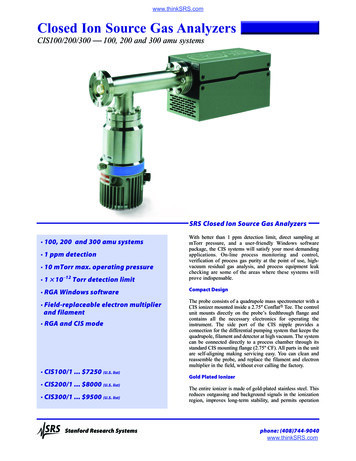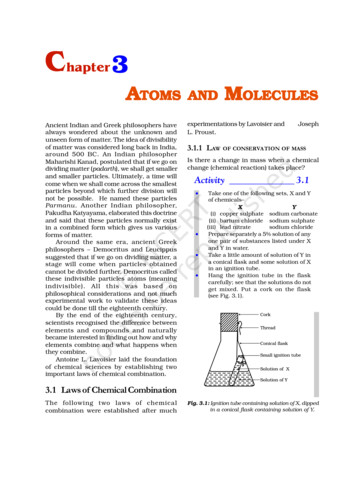
Transcription
Chapter 3ATOMSAncient Indian and Greek philosophers havealways wondered about the unknown andunseen form of matter. The idea of divisibilityof matter was considered long back in India,around 500 BC. An Indian philosopherMaharishi Kanad, postulated that if we go ondividing matter (padarth), we shall get smallerand smaller particles. Ultimately, a time willcome when we shall come across the smallestparticles beyond which further division willnot be possible. He named these particlesParmanu. Another Indian philosopher,Pakudha Katyayama, elaborated this doctrineand said that these particles normally existin a combined form which gives us variousforms of matter.Around the same era, ancient Greekphilosophers – Democritus and Leucippussuggested that if we go on dividing matter, astage will come when particles obtainedcannot be divided further. Democritus calledthese indivisible particles atoms (meaningindivisible). All this was based onphilosophical considerations and not muchexperimental work to validate these ideascould be done till the eighteenth century.By the end of the eighteenth century,scientists recognised the difference betweenelements and compounds and naturallybecame interested in finding out how and whyelements combine and what happens whenthey combine.Antoine L. Lavoisier laid the foundationof chemical sciences by establishing twoimportant laws of chemical combination.ANDMOLECULESexperimentations by Lavoisier andL. Proust.3.1.1 LAWJosephOF CONSERVATION OF MASSIs there a change in mass when a chemicalchange (chemical reaction) takes place?Activity 3.1 Take one of the following sets, X and Yof chemicals–X Y(i) copper sulphate sodium carbonate(ii) barium chloride sodium sulphate(iii) lead nitratesodium chloridePrepare separately a 5% solution of anyone pair of substances listed under Xand Y in water.Take a little amount of solution of Y ina conical flask and some solution of Xin an ignition tube.Hang the ignition tube in the flaskcarefully; see that the solutions do notget mixed. Put a cork on the flask(see Fig. 3.1).3.1 Laws of Chemical CombinationThe following two laws of chemicalcombination were established after muchFig. 3.1: Ignition tube containing solution of X, dippedin a conical flask containing solution of Y.
Weigh the flask with its contentscarefully.Now tilt and swirl the flask, so that thesolutions X and Y get mixed.Weigh again.What happens in the reaction flask?Do you think that a chemical reactionhas taken place?Why should we put a cork on the mouthof the flask?Does the mass of the flask and itscontents change? Law of conservation of mass states thatmass can neither be created nor destroyed ina chemical reaction.3.1.2 LAW OF CONSTANT PROPORTIONSLavoisier, along with other scientists, notedthat many compounds were composed of twoor more elements and each such compoundhad the same elements in the sameproportions, irrespective of where thecompound came from or who prepared it.In a compound such as water, the ratio ofthe mass of hydrogen to the mass of oxygenis always 1:8, whatever the source of water.Thus, if 9 g of water is decomposed, 1 g ofhydrogen and 8 g of oxygen are alwaysobtained. Similarly in ammonia, nitrogen andhydrogen are always present in the ratio 14:3by mass, whatever the method or the sourcefrom which it is obtained.This led to the law of constant proportionswhich is also known as the law of definiteproportions. This law was stated by Proustas “In a chemical substance the elements arealways present in definite proportions bymass”.The next problem faced by scientists wasto give appropriate explanations of these laws.British chemist John Dalton provided thebasic theory about the nature of matter.Dalton picked up the idea of divisibility ofmatter, which was till then just a philosophy.He took the name ‘atoms’ as given by theGreeks and said that the smallest particles ofmatter are atoms. His theory was based onthe laws of chemical combination. Dalton’s32atomic theory provided an explanation for thelaw of conservation of mass and the law ofdefinite proportions.John Dalton was born ina poor weaver’s family in1766 in England. Hebegan his career as ateacher at the age oftwelve. Seven years laterhe became a schoolprincipal. In 1793, Daltonleft for Manchester toteach mathematics,John Daltonphysics and chemistry ina college. He spent most of his life thereteaching and researching. In 1808, hepresented his atomic theory which was aturning point in the study of matter.According to Dalton’s atomic theory, allmatter, whether an element, a compound ora mixture is composed of small particles calledatoms. The postulates of this theory may bestated as follows:(i) All matter is made of very tiny particlescalled atoms.(ii) Atoms are indivisible particles, whichcannot be created or destroyed in achemical reaction.(iii) Atoms of a given element are identicalin mass and chemical properties.(iv) Atoms of different elements havedifferent masses and chemicalproperties.(v) Atoms combine in the ratio of smallwhole numbers to form compounds.(vi) The relative number and kinds ofatoms are constant in a givencompound.You will study in the next chapter that allatoms are made up of still smaller particles.Questions1. In a reaction, 5.3 g of sodiumcarbonate reacted with 6 g ofethanoic acid. The products were2.2 g of carbon dioxide, 0.9 gwater and 8.2 g of sodiumethanoate. Show that theseSCIENCE
observations are in agreementwith the law of conservation ofmass.sodium carbonate ethanoic acid sodium ethanoate carbondioxide water2. Hydrogen and oxygen combine inthe ratio of 1:8 by mass to formwater. What mass of oxygen gaswould be required to reactcompletely with 3 g of hydrogengas?3. Which postulate of Dalton’satomic theory is the result of thelaw of conservation of mass?4. Which postulate of Dalton’satomic theory can explain the lawof definite proportions?We might think that if atoms are soinsignificant in size, why should we care aboutthem? This is because our entire world ismade up of atoms. We may not be able to seethem, but they are there, and constantlyaffecting whatever we do. Through moderntechniques, we can now produce magnifiedimages of surfaces of elements showing atoms.3.2 What is an Atom?Have you ever observed a mason buildingwalls, from these walls a room and then acollection of rooms to form a building? Whatis the building block of the huge building?What about the building block of an ant-hill?It is a small grain of sand. Similarly, thebuilding blocks of all matter are atoms.How big are atoms?Atoms are very small, they are smaller thananything that we can imagine or comparewith. More than millions of atoms whenstacked would make a layer barely as thickas this sheet of paper.Atomic radius is measured in nanometres.1/10 9 m 1 nm1 m 109 nmFig. 3.2: An image of the surface of silicon3.2.1 W H A TARETHE MODERNDAYSYMBOLS OF ATOMS OF DIFFERENTELEMENTS?Dalton was the first scientist to use thesymbols for elements in a very specific sense.When he used a symbol for an element healso meant a definite quantity of that element,that is, one atom of that element. Berziliussuggested that the symbols of elements bemade from one or two letters of the name ofthe element.Relative SizesRadii (in m)10–10ExampleAtom of hydrogen10–9Molecule of water10–8Molecule of haemoglobin–410Grain of sand10–2Ant10–1WatermelonATOMSANDMOLECULESFig. 3.3: Symbols for some elements as proposed byDalton33
In the beginning, the names of elementswere derived from the name of the place wherethey were found for the first time. For example,the name copper was taken from Cyprus.Some names were taken from specific colours.For example, gold was taken from the Englishword meaning yellow.Now-a-days, IUPAC(International Union of Pure and AppliedChemistry) approves names of elements. Manyof the symbols are the first one or two lettersof the element’s name in English. The firstletter of a symbol is always written as a capitalletter (uppercase) and the second letter as asmall letter (lowercase).For example(i) hydrogen, H(ii) aluminium, Al and not AL(iii) cobalt, Co and not CO.Symbols of some elements are formedfrom the first letter of the name and a letter,appearing later in the name. Examples are:(i) chlorine, Cl, (ii) zinc, Zn etc.Other symbols have been taken from thenames of elements in Latin, German or Greek.For example, the symbol of iron is Fe from itsLatin name ferrum, sodium is Na fromnatrium, potassium is K from kalium.Therefore, each element has a name and aunique chemical symbol.the passage of time and repeated usage youwill automatically be able to reproduce thesymbols).3.2.2 ATOMIC MASSThe most remarkable concept that Dalton’satomic theory proposed was that of the atomicmass. According to him, each element had acharacteristic atomic mass. The theory couldexplain the law of constant proportions so wellthat scientists were prompted to measure theatomic mass of an atom. Since determiningthe mass of an individual atom was a relativelydifficult task, relative atomic masses weredetermined using the laws of chemicalcombinations and the compounds formed.Let us take the example of a compound,carbon monoxide (CO) formed by carbon andoxygen. It was observed experimentally that3 g of carbon combines with 4 g of oxygen toform CO. In other words, carbon combineswith 4/3 times its mass of oxygen. Supposewe define the atomic mass unit (earlierabbreviated as ‘amu’, but according to thelatest IUPAC recommendations, it is nowwritten as ‘u’ – unified mass) as equal to themass of one carbon atom, then we wouldassign carbon an atomic mass of 1.0 u andTable 3.1: Symbols for some oNeonNeZincZn(The above table is given for you to referto whenever you study about elements. Donot bother to memorise all in one go. With34oxygen an atomic mass of 1.33 u. However, itis more convenient to have these numbers aswhole numbers or as near to a whole numbersSCIENCE
as possible. While searching for variousatomic mass units, scientists initially took 1/16 of the mass of an atom of naturallyoccurring oxygen as the unit. This wasconsidered relevant due to two reasons: oxygen reacted with a large number ofelements and formed compounds. this atomic mass unit gave masses ofmost of the elements as whole numbers.However, in 1961 for a universallyaccepted atomic mass unit, carbon-12 isotopewas chosen as the standard reference formeasuring atomic masses. One atomic massunit is a mass unit equal to exactly one-twelfth(1/12th) the mass of one atom of carbon-12.The relative atomic masses of all elementshave been found with respect to an atom ofcarbon-12.Imagine a fruit seller selling fruits withoutany standard weight with him. He takes awatermelon and says, “this has a mass equalto 12 units” (12 watermelon units or 12 fruitmass units). He makes twelve equal pieces ofthe watermelon and finds the mass of eachfruit he is selling, relative to the mass of onepiece of the watermelon. Now he sells his fruitsby relative fruit mass unit (fmu), as in Fig.3.4.mass of the atom, as compared to 1/12th themass of one carbon-12 atom.Table 3.2: Atomic masses ofa few elementsElementAtomic Mass esium24Sulphur32Chlorine35.5Calcium403.2.3 HOW DO ATOMS EXIST?Atoms of most elements are not able to existindependently. Atoms form molecules andions. These molecules or ions aggregate inlarge numbers to form the matter that we cansee, feel or touch.Fig. 3.4 : (a) Water melon, (b) 12 pieces, (c) 1/12 ofuestionsQ1. Define the atomic mass unit.2. Why is it not possible to see anatom with naked eyes?3.3 What is a Molecule?water melon, (d) how the fruit seller canweigh the fruits using pieces ofwater melonSimilarly, the relative atomic mass of theatom of an element is defined as the averageATOMSANDMOLECULESA molecule is in general a group of two ormore atoms that are chemically bondedtogether, that is, tightly held together byattractive forces. A molecule can be definedas the smallest particle of an element or acompound that is capable of an independentexistence and shows all the properties of thatsubstance. Atoms of the same element or ofdifferent elements can join together to formmolecules.35
3.3.1 MOLECULES OF ELEMENTSThe molecules of an element are constitutedby the same type of atoms. Molecules of manyelements, such as argon (Ar), helium (He) etc.are made up of only one atom of that element.But this is not the case with most of the nonmetals. For example, a molecule of oxygenconsists of two atoms of oxygen and hence itis known as a diatomic molecule, O2. If 3atoms of oxygen unite into a molecule, insteadof the usual 2, we get ozone. The number ofatoms constituting a molecule is known asits atomicity.Metals and some other elements, such ascarbon, do not have a simple structure butconsist of a very large and indefinite numberof atoms bonded together.Let us look at the atomicity of somenon-metals.Table 3.3 : Atomicity of someelementsType iobyMassWaterHydrogen, Oxygen1:8AmmoniaNitrogen, Hydrogen14:3CarbondioxideCarbon, Oxygen3:8Activity phorusTetra-atomicSulphurPoly-atomicAtoms of different elements join together indefinite proportions to form molecules ofcompounds. Few examples are given in Table3.4.Refer to Table 3.4 for ratio by mass ofatoms present in molecules and T able3.2 for atomic masses of elements. Findthe ratio by number of the atoms ofelements in the molecules ofcompounds given in Table 3.4.The ratio by number of atoms for awater molecule can be found as follows: Element Ratio Atomic Mass Simplestbymass ratio/ratiomass(u)atomicmassAtomicity3.3.2 MOLECULES OF COMPOUNDS36Table 3.4 : Molecules of somecompounds1H11O8161 18 1621 21Thus, the ratio by number of atoms forwater is H:O 2:1.3.3.3 WHAT IS AN ION?Compounds composed of metals and nonmetals contain charged species. The chargedspecies are known as ions. An ion is a chargedparticle and can be negatively or positivelycharged. A negatively charged ion is called an‘anion’ and the positively charged ion, a‘cation’. Take, for example, sodium chloride(NaCl). Its constituent particles are positivelycharged sodium ions (Na ) and negativelycharged chloride ions (Cl–). Ions may consistof a single charged atom or a group of atomsSCIENCE
that have a net charge on them. A group ofatoms carrying a charge is known as apolyatomic ion (Table 3.6). We shall learn moreabout the formation of ions in Chapter 4.Table 3.5: Some ionic assCalcium oxideCalcium andoxygen5:2MagnesiumsulphideMagnesiumand sulphur3:4SodiumchlorideSodiumand chlorine23:35.53.4 Writing Chemical FormulaeThe chemical formula of a compound is asymbolic representation of its composition.The chemical formulae of differentcompounds can be written easily. For thisexercise, we need to learn the symbols andcombining capacity of the elements.The combining power (or capacity) of anelement is known as its valency. Valency canbe used to find out how the atoms of anelement will combine with the atom(s) ofanother element to for m a chemicalcompound. The valency of the atom of anelement can be thought of as hands or armsof that atom.Human beings have two arms and anoctopus has eight. If one octopus has to catchhold of a few people in such a manner that allthe eight arms of the octopus and both armsof all the humans are locked, how manyhumans do you think the octopus can hold?Represent the octopus with O and humanswith H. Can you write a formula for thiscombination? Do you get OH4 as the formula?The subscript 4 indicates the number ofhumans held by the octopus.The valencies of some common ions aregiven in Table 3.6. We will learn more aboutvalency in the next chapter.Table 3.6: Names and symbols of some ionsValencyName ofion1.SodiumPotassiumSilverCopper (I)*SymbolNa K Ag Cu enHydrideChlorideBromideIodideH NH4 OH–NO3–HCO–32.MagnesiumCalciumZincIron (II)*Copper (II)*Mg2 Ca2 Zn2 Fe2 Cu2 SO32–SO42–3.AluminiumIron (III)*Al3 Fe3 NitrideN3-PhosphatePO43–* Some elements show more than one valency. A Roman numeral shows their valency in a bracket.ATOMSANDMOLECULES37
The rules that you have to follow while writinga chemical formula are as follows: the valencies or charges on the ion mustbalance. when a compound consists of a metal anda non-metal, the name or symbol of themetal is written first. For example:calcium oxide (CaO), sodium chloride(NaCl), iron sulphide (FeS), copper oxide(CuO) etc., where oxygen, chlorine,sulphur are non-metals and are writtenon the right, whereas calcium, sodium,iron and copper are metals, and arewritten on the left. in compounds formed with polyatomic ions,the ion is enclosed in a bracket before writingthe number to indicate the ratio. In casethe number of polyatomic ion is one, thebracket is not required. For example, NaOH.3.4.1 FORMULAE OF SIMPLE COMPOUNDSThe simplest compounds, which are made upof two different elements are called binarycompounds. Valencies of some ions are givenin Table 3.6. You can use these to writeformulae for compounds.While writing the chemical formulae forcompounds, we write the constituent elementsand their valencies as shown below. Then wemust crossover the valencies of the combiningatoms.3. Formula of carbon tetrachlorideFor magnesium chloride, we write thesymbol of cation (Mg2 ) first followed by thesymbol of anion (Cl- ). Then their charges arecriss-crossed to get the formula.4.Formula of magnesium chlorideFormula : MgCl2Thus, in magnesium chloride, there aretwo chloride ions (Cl-) for each magnesiumion (Mg2 ). The positive and negative chargesmust balance each other and the overallstructure must be neutral. Note that in theformula, the charges on the ions are notindicated.Some more examples(a)Formula for aluminium oxide:Examples1. Formula of hydrogen chlorideFormula : Al 2O3(b)Formula for calcium oxide:Formula of the compound would be HCl.2. Formula of hydrogen sulphideHere, the valencies of the two elementsare the same. You may arrive at the formulaCa2O 2. But we simplify the formula as CaO.38SCIENCE
(c) Formula of sodium nitrate:Formula : NaNO3(d) Formula of calcium hydroxide:Formula : Ca(OH)2Note that the formula of calciumhydroxide is Ca(OH)2 and not CaOH2. We usebrackets when we have two or more of thesame ions in the formula. Here, the bracketaround OH with a subscript 2 indicates thatthere are two hydroxyl (OH) groups joined toone calcium atom. In other words, there aretwo atoms each of oxygen and hydrogen incalcium hydroxide.following formulae:(i) Al 2(SO4)3(ii) CaCl2(iii) K 2SO4(iv) KNO3(v) CaCO3.3. What is meant by the termchemical formula?4. How many atoms are present in a(i) H 2S molecule and(ii) PO 43– ion?3.5 Molecular Mass and MoleConcept3.5.1 MOLECULAR MASSIn section 3.2.2 we discussed the concept ofatomic mass. This concept can be extendedto calculate molecular masses. The molecularmass of a substance is the sum of the atomicmasses of all the atoms in a molecule of thesubstance. It is therefore the relative mass ofa molecule expressed in atomic mass units (u).(e) Formula of sodium carbonate:Formula : Na2CO 3In the above example, brackets are not neededif there is only one ion present.(f) Formula of ammonium sulphate:Formula : (NH4)2SO4QATOMSuestions1. Write down the formulae of(i) sodium oxide(ii) aluminium chloride(iii) sodium suphide(iv) magnesium hydroxide2. Write down the names ofcompounds represented by theANDMOLECULESExample 3.1 (a) Calculate the relativemolecular mass of water (H 2O).(b) Calculate the molecular mass ofHNO3.Solution:(a) Atomic mass of hydrogen 1u,oxygen 16 uSo the molecular mass of water, whichcontains two atoms of hydrogen and oneatom of oxygen is 2 1 1 16 18 u(b) The molecular mass of HNO3 theatomic mass of H the atomic mass ofN 3 the atomic mass of O 1 14 48 63 u3.5.2 FORMULA UNIT MASSThe formula unit mass of a substance is asum of the atomic masses of all atoms in aformula unit of a compound. Formula unitmass is calculated in the same manner as wecalculate the molecular mass. The only39
difference is that we use the word formulaunit for those substances whose constituentparticles are ions. For example, sodiumchloride as discussed above, has a formulaunit NaCl. Its formula unit mass can becalculated as–1 23 1 35.5 58.5 uExample 3.2 Calculate the formula unitmass of CaCl2.Solution:Atomic mass of Ca (2 atomic mass of Cl) 40 2 35.5 40 71 111 uQuestions1. Calculate the molecular massesof H2, O 2, Cl2, CO2, CH4, C2H6,C 2H4, NH3, CH3OH.2. Calculate the formula unitmasses of ZnO, Na2O, K2CO3,given atomic masses of Zn 65 u,Na 23 u, K 39 u, C 12 u,and O 16 u.3.5.3 MOLE CONCEPTTake an example of the reaction of hydrogenand oxygen to form water:2H2 O2 2H 2O.The above reaction indicates that(i) two molecules of hydrogen combinewith one molecule of oxygen to formtwo molecules of water, or(ii) 4 u of hydrogen molecules combinewith 32 u of oxygen molecules to form36 u of water molecules.We can infer from the above equation thatthe quantity of a substance can becharacterised by its mass or the number ofmolecules. But, a chemical reaction equationindicates directly the number of atoms ormolecules taking part in the reaction.Therefore, it is more convenient to refer to thequantity of a substance in terms of thenumber of its molecules or atoms, rather thantheir masses. So, a new unit “mole” wasintroduced. One mole of any species (atoms,Fig. 3.5: Relationship between mole, Avogadro number and mass40SCIENCE
molecules, ions or particles) is that quantityin number having a mass equal to its atomicor molecular mass in grams.The number of particles (atoms, moleculesor ions) present in 1 mole of any substance isfixed, with a value of 6.022 1023. This is anexperimentally obtained value. This numberis called the Avogadro Constant or AvogadroNumber (represented by N0), named in honourof the Italian scientist, Amedeo Avogadro.1 mole (of anything) 6.022 10 23 in number,as, 1 dozen 12 nos.1 gross 144 nos.Besides being related to a number, a molehas one more advantage over a dozen or agross. This advantage is that mass of 1 moleof a particular substance is also fixed.The mass of 1 mole of a substance is equalto its relative atomic or molecular mass ingrams. The atomic mass of an element givesus the mass of one atom of that element inatomic mass units (u). To get the mass of1 mole of atom of that element, that is, molarmass, we have to take the same numericalvalue but change the units from ‘u’ to ‘g’. Molarmass of atoms is also known as gram atomicmass. For example, atomic mass ofhydrogen 1u. So, gram atomic mass ofhydrogen 1 g.1 u hydrogen has only 1 atom of hydrogen1 g hydrogen has 1 mole atoms, that is,6.022 10 23 atoms of hydrogen.Similarly,16 u oxygen has only 1 atom of oxygen,16 g oxygen has 1 mole atoms, that is,6.022 10 23 atoms of oxygen.To find the gram molecular mass or molarmass of a molecule, we keep the numericalvalue the same as the molecular mass, butsimply change units as above from u to g. Forexample, as we have already calculated,molecular mass of water (H2O) is 18 u. Fromhere we understand that18 u water has only 1 molecule of water,18 g water has 1 mole molecules of water,that is, 6.022 1023 molecules of water.Chemists need the number of atoms andmolecules while carrying out reactions, andfor this they need to relate the mass in gramsATOMSANDMOLECULESto the number. It is done as follows:1 mole 6.022 1023 number Relative mass in grams.Thus, a mole is the chemist’s counting unit.The word “mole” was introduced around1896 by Wilhelm Ostwald who derived theterm from the Latin word moles meaning a‘heap’ or ‘pile’. A substance may be consideredas a heap of atoms or molecules. The unitmole was accepted in 1967 to provide a simpleway of reporting a large number– the massiveheap of atoms and molecules in a sample.Example 3.31. Calculate the number of moles for thefollowing:(i) 52 g of He (finding mole frommass)(ii) 12.044 1023 number of He atoms(finding mole from number ofparticles).Solutions:No. of molesGiven massMolar massGiven number of particlesAvogadro number of particles (i) 4u 4gAtomic mass of HeMolar mass of HenmMNN0Thus, the number of molesgiven mass molar mass n (ii)m 52 13M4we know,1 mole 6.022 1023The number of moles given number of particlesAvogadro number n N 12.044 10 23 2No6.022 102341
Example 3.4 Calculate the mass of thefollowing:(i) 0.5 mole of N 2 gas (mass from moleof molecule)(ii) 0.5 mole of N atoms (mass frommole of atom)(iii) 3.011 1023 number of N atoms(mass from number)(iv) 6.022 10 2 3 number of N 2molecules (mass from number)Solutions:( i) N (ii) The number of molecules given mass Avogadro numbermolar massm N0Matomic massof oxygen 16 umass molar mass number ofmoles m M n 14 0.5 7 g N molar mass of O2 molecules 16 2 32g(iii) The number of moles, n m N0M46 6.022 102 323 N 12.044 10 23mass molar mass number ofmoles Avogadro number N m M n 28 0.5 14 g(ii)given massmolar massSolutions:(i)The number of atomsgiven number of particles N Avogadro numberN08 6.022 102332 N 1.5055 102 3 N 3.011 10 236.022 1023 1.51 102 323 m M n 14 3.011 106.022 102 3(iii) The number of particles (atom) number of moles of particles Avogadro numberN n N0 0.1 x 6.022 1023 6.022 10 22 14 0.5 7 gN(iv) n N0 m M N6.022 10 23 28 N06.022 10 23 28 1 28 gExample 3.5 Calculate the number ofparticles in each of thefollowing:(i) 46 g of Na atoms (number frommass)(ii) 8 g O 2 molecules (number ofmolecules from mass)(iii) 0.1 mole of carbon atoms (numberfrom given moles)42Questions1. If one mole of carbon atomsweighs 12 grams, what is themass (in grams) of 1 atom ofcarbon?2. Which has more number ofatoms, 100 grams of sodium or100 grams of iron (given, atomicmass of Na 23 u, Fe 56 u)?SCIENCE
Whatyou havelearnt During a chemical reaction, the sum of the masses of thereactants and products remains unchanged. This is knownas the Law of Conservation of Mass.In a pure chemical compound, elements are always present ina definite proportion by mass. This is known as the Law ofDefinite Proportions.An atom is the smallest particle of the element that cannotusually exist independently and retain all its chemicalproperties.A molecule is the smallest particle of an element or a compoundcapable of independent existence under ordinary conditions.It shows all the properties of the substance.A chemical formula of a compound shows its constituentelements and the number of atoms of each combining element.Clusters of atoms that act as an ion are called polyatomic ions.They carry a fixed charge on them.The chemical formula of a molecular compound is determinedby the valency of each element.In ionic compounds, the charge on each ion is used todetermine the chemical formula of the compound.Scientists use the relative atomic mass scale to compare themasses of different atoms of elements. Atoms of carbon-12isotopes are assigned a relative atomic mass of 12 and therelative masses of all other atoms are obtained by comparisonwith the mass of a carbon-12 atom.The Avogadro constant 6.022 1023 is defined as the numberof atoms in exactly 12 g of carbon-12.The mole is the amount of substance that contains the samenumber of particles (atoms/ ions/ molecules/ formula unitsetc.) as there are atoms in exactly 12 g of carbon-12.Mass of 1 mole of a substance is called its molar mass.Exercises1. A 0.24 g sample of compound of oxygen and boron was foundby analysis to contain 0.096 g of boron and 0.144 g of oxygen.Calculate the percentage composition of the compound byweight.2. When 3.0 g of carbon is burnt in 8.00 g oxygen, 11.00 g ofcarbon dioxide is produced. What mass of carbon dioxide willATOMSANDMOLECULES43
3.4.5.6.7.8.9.10.11.44be formed when 3.00 g of carbon is burnt in 50.00 g of oxygen?Which law of chemical combination will govern your answer?What are polyatomic ions? Give examples.Write the chemical formulae of the following.(a) Magnesium chloride(b) Calcium oxide(c) Copper nitrate(d) Aluminium chloride(e) Calcium carbonate.Give the names of the elements present in the followingcompounds.(a) Quick lime(b) Hydrogen bromide(c) Baking powder(d) Potassium sulphate.Calculate the molar mass of the following substances.(a) Ethyne, C2H2(b) Sulphur molecule, S 8(c) Phosphorus molecule, P4 (Atomic mass of phosphorus 31)(d) Hydrochloric acid, HCl(e) Nitric acid, HNO3What is the mass of—(a) 1 mole of nitrogen atoms?(b) 4 moles of aluminium atoms (Atomic mass of aluminium 27)?(c) 10 moles of sodium sulphite (Na2SO3)?Convert into mole.(a) 12 g of oxygen gas(b) 20 g of water(c)22 g of carbon dioxide.What is the mass of:(a) 0.2 mole of oxygen atoms?(b) 0.5 mole of water molecules?Calculate the number of molecules of sulphur (S8) present in16 g of solid sulphur.Calculate the number of aluminium ions present in 0.051 g ofaluminium oxide.(Hint: The mass of an ion is the same as that of an atom of thesame element. Atomic mass of Al 27 u)SCIENCE
Group ActivityPlay a game for writing formulae.Example1 : Make placards with symbols and valencies of theelements separately. Each student should hold twoplacards, one with the symbol in the right hand andthe other with the valency in the left hand. Keepingthe symbols in place, students should
10–4 Grain of sand 10–2 Ant 10–1 Watermelon Fig. 3.2: An image of the surface of silicon 3.2.1 WHAT ARE THE MODERN DAY SYMBOLS OF ATOMS OF DIFFERENT ELEMENTS? Dalton was the first scientist to use the symbols for elements in a very specific sense. When he used a symbol for an e


